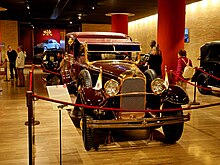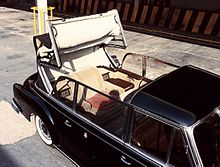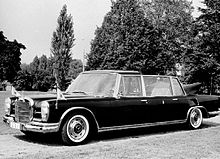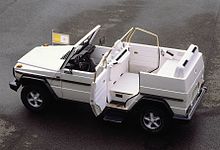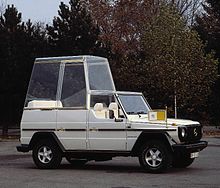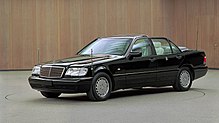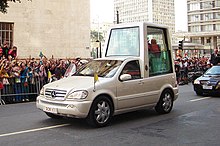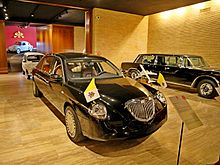Popemobile
The papamobile ( Pope's car ) (shortened from Italian papa “Pope” and (auto) mobile “car”) - more rarely Pope's mobile - are the vehicles that the Pope uses during his public appearances.
The term first became popular with John Paul II , whose pontificate was characterized by an increased awareness of the representative aspects of his office. As part of his extensive travel activities (he made more visits abroad than all previous Popes put together), papamobiles of different brands were used particularly often, which were characterized by three characteristics:
- elevated place of the Pope, which since the assassination attempt in 1981 is mostly secured with bulletproof glass ,
- a special transmission for driving at walking pace or automatic transmission as well
- a special chair on which Pope John Paul II could even be carried into the Popemobile.
The term was also used for the motor vehicles of his successor Benedict XVI. used. During the final service of World Youth Day 2005, he himself referred to his vehicle as “my dad's car”, with which he would have liked to drive “all over the place” through the crowd in order to be close to more believers.
Currently (2006) there are around 60 papamobiles. Several vehicles are carried when traveling abroad . Usually the local bishop and the papal private secretary sit in the vehicle .
history
The papamobiles are a novelty under the pontificate of John Paul II. His predecessors in office had far less contact with the public and hardly undertook worldwide trips. When they appeared in public, they were in the traditional sedia gestatoria , a kind of portable throne, although they too had been around since Pius XI. Cars owned, although not the typical design had were not very well known nor Popemobile were called, but only typical state carriages were.
The Papamobiles used on the 104 official trips abroad of Pope John Paul II remained mostly in the destination country and were used again when they visited again. The Mexican popemobile for example, was reactivated at the funeral of the Pope and the public shown.
The first Popemobile used was designed for the trip to Poland between June 2 and 10, 1979 and was based on a Star 660 (three-axle off-road truck of military origin with all-wheel drive ) from the Polish brand Star .
The Mercedes-Benz company has a long tradition with the Vatican . Already in 1930 Pope Pius XI. the first time a limousine type Nürburg 460 paid. In 1960 Pope John XXIII received a so-called " Adenauer Mercedes " with special equipment was also given. Less known is the commitment of Lancia , a company that traditionally maintains good relations with the Vatican, and has also provided Papamobile, but without communicating this effectively. However, the Vatican has a large fleet of other manufacturers, including Fiat and other European car companies.
Pope Francis relies on simpler cars for the first time. During his trip to Brazil in 2013, he used a basic Fiat Idea and drove it up to the President's welcome ceremony.
Pope's license plate number
Another special feature are the license plates of the Vatican's motor vehicles. All state-owned vehicles of the Vatican have license plates that begin with SCV . The civilian cars only have a CV . The letters SCV stand for Stato della Città del Vaticano (Italian) or Status Civitatis Vaticanae ( Latin ) (German translation: Vatican City State - or literally: State of the City of the Vatican). In the vernacular, other meanings have crept in; the best-known backronym is "se cristo vedesse" (if Christ would see that).
Usually the license plate SCV 1 is used for the vehicle used by the Pope. Certain cars, such as the historic Mercedes Nürburg from 1930 (SCV 4) and the two Mercedes-Benz G models (SCV 6 and 7), are assigned fixed numbers, but no consistent system can be recognized.
It can be both a “popemobile” and a classic “state car”. The latter are still available in the Vatican's fleet, but (especially since the time of John Paul II) have only rarely been used for the general audiences, but more often for journeys within the Vatican City and within the city of Rome.
Brands used
Cadillac
In 1999, Cadillac had made a car based on a DeVille for Pope John Paul II's visit to Mexico .
Fiat
Benedict XVI. took over a Fiat Campagnola with four-wheel drive from John Paul II .
Land Rover
In 1982 the Pope drove in a converted Range Rover on his visit to England .
Mercedes Benz
Since 1930 Mercedes-Benz has been building various converted limousines , landaulets and off-road vehicles in special versions as vehicles of the Pope for the Vatican .
1930 - Mercedes-Benz type Nürburg 460
The basis of the papal automobile for Pope Pius XI. was the Mercedes-Benz Nürburg 460 presented in 1928 . The sedan of the W08 series was equipped with an eight-cylinder in-line engine with a displacement of 4622 cubic centimeters. The engine developed 80 hp at 3400 revolutions per minute and reached a top speed of 100 km / h. In contrast to the first models from 1928 with a high frame, the chassis selected for the “Rome Car” (the internal name of the project) had a modern low frame. The chassis, engine and body were hardly changed for the papal car .
However, the interior of the Pullman limousine was rebuilt all the more thoroughly . The Nürburg type was produced in the Mannheim plant and rebuilt in the Sindelfingen plant . The seats for the chauffeur and front passenger were upholstered with black leather, for the Pope a throne chair with air cushions was created in the rear of the Nürburg, covered with fine silk brocade. The inner covering of the car roof was of particular artistic quality: The motif - the Holy Spirit , symbolized by a dove - was designed by Father Cornelius, the art expert for parament embroidery of the Benedictine order in the Beuron monastery . The designs were implemented by embroiderers from a Benedictine monastery on the finest materials. The designers selected fine woods and metals to match the embroidery to equip the Pope's chariot.
Shatterproof glass from the Cologne company Kinon with a tint to protect against solar radiation was used for the windows . The "Kinonglas" was an early form of laminated glass , consisting of two glass surfaces with a foil inserted between them. A signaling device for passengers was also state-of-the-art : the Pope was able to give his chauffeur instructions on speed and destination via a control panel.
After a mileage of around 40,000 kilometers, the Mercedes-Benz Nürburg was taken out of active service in the vehicle fleet and shown together with other vehicles of the Popes in the Museum of the Vatican State. While the frame and sheet metal of the car were still in good condition after years of use, the wooden parts and interior fittings required a refurbishment 50 years after it was built in order to keep the unique vehicle in its original condition. That is why the Nürburg model came back to Stuttgart in 1983. Pope John Paul II received the Mercedes-Benz in the Vatican in autumn 1984. Since then, the Pope's chariot has been shown again in the Vatican's Museo Storico Vaticano .
1960 - Mercedes-Benz Type 300 d Landaulet
The Mercedes-Benz of the W 189 series for Pope Johannes XXIII. came from ongoing production; however, had a 450 mm longer wheelbase. In contrast to the sedan from 1930, this second Mercedes-Benz from the Vatican was designed as a landaulet . This form of construction - with a fixed roof over the front seats and a hood over the rear - was the classic choice for representative vehicles with chauffeur. Due to the longer wheelbase, the total length of the car increased to 5.64 meters. Compared to the production vehicles, the Mercedes was also slightly higher.
The car had a 3-speed automatic transmission and the standard inline six-cylinder with three liters of displacement and 160 hp. If necessary, the papal car managed a top speed of 160 km / h. Most of the time, however, the vehicle was used at a moderate pace on official occasions. On these occasions, the side windows in the rear could be completely removed with the convertible top open and stored in brackets specially built into the trunk. In contrast to these rear plug-in windows, the partition between the rear and front seats and the front windows were equipped with electric drives and could be lowered. The locks for the convertible top mechanism were accessible from the driver's seat, the convertible top itself could be opened and closed within a few seconds. When the rear doors were opened, running boards automatically came out of the car floor to make it easier for the Pope to get in and out. The arrangement of the seats in the rear of the vehicle corresponded to the structure of the “Rome Car” from 1930 with the throne chair of the Pontifex Maximus facing the direction of travel and two folding seats for the Pope's companions on the partition wall to the front seats.
The Pope's seat had an electric fore / aft adjustment, the same adjustment option for the seat back and was provided with controls for air conditioning , radio and other functions. Stable handles on the partition wall of the 300 d gave the Pope support when he gave the blessing while standing.
1965 - Mercedes-Benz 600 Pullman Landaulet
The custom-made Mercedes-Benz 600 Pullman landaulet was created in collaboration between the testing department and production in Sindelfingen. The carriage for Pope Paul VI. was based on the Mercedes-Benz 600 of the W100 series with a long wheelbase (3900 millimeters). Compared to the series, however, the equipment had changed. The rear doors were widened by 256 millimeters and connected directly to the front doors. The rear doors were also given new controls. This made them easier to reach from the Pope's single seat located in the center of the rear. The roof of the Pullman landaulet has been raised by 70 millimeters to allow sufficient headroom. The floor of the vehicle was flat in the rear, the transmission tunnel disappeared under a flat surface. The vehicle's additional special equipment included a cooling system, the intercom system for contacting the driver and the single armchair in the rear that can be moved in several directions. For the Pope's companions, however, there were still only folding seats facing the direction of travel.
1966 - Mercedes-Benz 300 SEL Landaulet
Just one year after the Mercedes-Benz 600 was handed over to the Holy See, another landaulet vehicle was delivered. This time, the basis of the car was the W109 series . From a Mercedes-Benz 300 SEL limousine with a normal wheelbase (2850 millimeters), the Pope's car was created with a single seat that could be moved to the right to create space for a passenger on the folding seat on the partition.
The car was used in parallel to the larger W 100 series car for a long time. The 300 SEL did not have as luxurious equipment as the Mercedes-Benz 600, for example the short landaulet managed without air conditioning. However, the vehicle was subsequently armored in 1981.
1967 - Mercedes-Benz 300 SEL long
The two sedans from the W109 series that Mercedes-Benz delivered to the Vatican in the spring of 1967 were each lengthened by 650 millimeters . The 300 SEL Pullman sedans had widened doors in the rear and emergency seats facing the direction of travel. In contrast to the landaulets, the two six-seater cars with a wheelbase of 3500 millimeters were not used for official representation drives. They were mainly used to chauffeur high-ranking guests of the Vatican.
1980 - Mercedes-Benz 230 G with special body
All previous papal vehicles were touring limousines, which should above all offer representativeness and comfort on long journeys. Under John Paul II, however, a completely new "specification sheet" was created; What was required was as close contact as possible with the crowds at public appearances:
- Above all, the Pope should be easy to see for the faithful (= elevated sitting or standing position, strong interior lighting),
- as close as possible to shaking hands or blessing (= no throne in the middle of the vehicle)
- Can also be used off-road (= all-terrain chassis, all-wheel drive)
- constant pace even at walking pace; The special gear ensures a constantly slow driving speed of 3 km / h (= corresponding gear steps)
- simple elegance (= vehicle color white)
- Long-distance suitability was no longer required of these vehicles.
For many years this vehicle was the ultimate papal car: the Mercedes-Benz 230 G off-road vehicle, painted in mother-of-pearl, accompanied Pope John Paul II on numerous trips around the world. Mercedes-Benz first made the vehicle available to the Pope for his visit to Germany in the late autumn of 1980 - initially on loan.
Because the Papstwagen also had to cover stretches off the beaten track, the base vehicle was the Mercedes-Benz G-Class ( W 460 series ) with a long wheelbase. The developers at Mercedes-Benz broke new ground in designing the body. Because classic body shapes like the landaulet could hardly be combined with the base of the off-road vehicle. Mercedes-Benz created the Pope's car with the high, transparent dome made of plastic, under which the Pope was driven either standing or sitting. Initially, the dome was designed so that it could be removed when the weather was nice. But after the attack on Pope John Paul II on May 13, 1981, the plastic glass structure remained on the wagon for safety reasons.
A powerful automatic climate control for the rear of the Pope's car ensured pleasant temperatures in the Pope's compartment in summer, and in rainy weather and high humidity, the system prevented the windows from fogging up. In addition, various spotlights were built into the sides, floor and roof of the dome, with which the Pope could be illuminated indirectly and directly in order to make his person clearly visible even in the dark.
As in the Mercedes-Benz landaulets, the floor in the rear has been raised. Where this measure only covered the cardan tunnel in the case of the passenger car, the designers raised the floor of the G-Class by 40 centimeters and created a raised platform for the Pope and his seat. The batteries, which continuously operate the extensive electrical system of the vehicle independently of the generator, were located underneath. These devices also included electric running boards, the steps of which could be extended to make it easier for the Pontifex Maximus to get in and out.
The G-Class with its two-tier structure made of transparent plastic was the first Papst automobile with a completely new design language. In addition to the viewing dome, this also included the installation of a continuous bench in the rear instead of a throne chair. Pope John Paul II insisted on this detail. But it was not just the body that distinguished the new Pope's car from the established state vehicles of the Vatican: Instead of black paintwork, the G-Class was designed in the Pope's colors, white and gold. The mother-of-pearl lacquer was complemented by gold-colored anodized trim and brass profiles. Inside, white wool velor and white leather were used.
In the spring of 1982, Mercedes-Benz donated the G-Class, built in 1980, to the Vatican for the Pope's vehicle fleet. In addition, a second, identical vehicle was created for the Pope based on this concept. The newer Pope car based on the Mercedes-Benz 230 GE (W 460 GE 23 series) had the license plate SCV 6, its twin brother built first, based on the 230 G, usually had the license plate SCV 7.
The G-Class vehicles developed 74 kW (100 PS) and 92 kW (125 PS) from the four-cylinder engines with a displacement of 2.3 liters and automatic transmission. The 4392 mm long, 1,950 m wide and around 2,800 m high car received a particularly comfortable suspension to ensure the Pope a ride without jolts even in the field. In 1983 and 1985, the equipment of the Mercedes-Benz G-Class was adapted to meet the higher security requirements of the Vatican.
Was changed in Austria the Pope also a detail of the exterior of the car's visit in 1983: Instead of the Mercedes star on the grille, the badge was of Puch mounted. The G-Class, a joint product of Mercedes-Benz and Steyr Daimler Puch , was sold in Austria under this brand . The concept of the off-road vehicle with a transparent safety structure was also adopted by other Mercedes-Benz manufacturers in the following years in order to provide the Pope with vehicles locally when he traveled.
1985 - Mercedes-Benz 500 SEL
Despite the media presence of the new Pope's car, John Paul II continued to use classic limousines and landaulets. The picture of his first exit after the election showed the new Pope in 1978 in the Mercedes-Benz 300 SEL Landaulet of the W109 series . From the summer of 1985 onwards, the Pope could choose between landaulet and limousine; John Paul II handed over the Mercedes-Benz to a Mercedes-Benz 500 SEL of the V 126 series in a special protection version .
The dimensions of the new car, which was supposed to replace the Mercedes-Benz 600 from 1965 as the official vehicle of the Pope, were significantly changed compared to the series: the sedan was given a wheelbase that was 200 millimeters longer and a roof 30 millimeters higher. In the rear, the vehicle offered a single seat for the Pope, opposite two folding seats. The arrangement of the seats in the new 500 SEL corresponded to that in the Mercedes-Benz Nürburg, which had been handed over 55 years earlier.
In contrast to the vehicle from 1930, the limousine offered the Pope the opportunity to show himself to the public despite the special protection design. For this purpose, a sliding roof lengthened by 100 millimeters was installed in front of the rear seat. Two small platforms powered by electric motors were installed under the roof window. These could be extended to the level of the cardan tunnel and thus offered a level platform with a significantly larger standing height compared to the floor. To protect the Pope from the wind, a shield made of six millimeter thick polycarbonate could be extended in front of the roof window .
With the roof open and the shield extended, the sedan drove a maximum of 30 km / h. When closed, the car ran with a gross vehicle weight of over three tons (empty weight 2673 kilograms) up to 160 km / h.
1997 - Mercedes-Benz S 500 long landaulet
The landaulet based on an S 500 long S-Class ( 140 series ) was handed over to the Vatican in 1997.
Based on the S-Class with a long wheelbase, a landaulet with an electro-hydraulically operated hood was created, which offered the Pope a lot of space in its single seat. In accordance with the Pope's older Mercedes-Benz landaulets, two foldable emergency seats were installed opposite the white upholstered armchair on the back of the partition wall to the driver's area. The individual chair in the vehicle was equipped with a particularly large vertical adjustment range of 500 millimeters. This made it easier for the Pope to get up. The roof of the landaulet was also designed in such a way that when closed it had a roof height of around 50 millimeters greater than that of the series sedan. The S 500 Landaulet had a V8 engine with a displacement of 5 liters, 235 kW (320 hp) and was equipped with a five-speed automatic. In addition to the landaulet body with a soft top and handles , the individual seat, the communication device and a partition, the special equipment of the new Pope automobile also included an icon of Saint Mary . The picture had been built into the paneling of the partition to the driver in front of the Pope's chair.
2002 - Mercedes-Benz ML 430 with special body
On World Youth Day 2002 in Toronto , Pope John Paul II appeared for the first time in the new Pope car based on the Mercedes-Benz M-Class .
The special body of the vehicle ( W163 series ) was based on its predecessors with G-Class chassis. The viewing dome of the M-Class, however, was no longer designed as an angular attachment. When the Pope first drafted an automobile based on the G-Class, this compact cube made of state-of-the-art plastic was the ideal solution; the dome could be easily separated from the chassis of the converted off-road vehicle if necessary. For the new M-Class, however, use without the protective windows was no longer an option. For example, the designers at Mercedes-Benz created a special body, the sides of which pull up behind the front doors and form a frame for the large windows that surround the Pope's seat. With the V8 engine with a displacement of 4.3 liters and a maximum output of 205 kW (279 hp), the ML 430 was appropriately motorized as the base vehicle of the new Pope's car. Like the predecessor vehicles of the G-Class, the papal M-Class was painted in mother-of-pearl and equipped with white inside.
2007 - Mercedes-Benz G 500 (audience car)
Pope Benedict XVI has been using a Mercedes-Benz G 500 since the end of 2007 to show himself to the faithful at the Wednesday public audiences. The car painted in mother-of-pearl replaces the previous Fiat Campagnola. The new model has a removable weather protection dome.
2012 - Mercedes-Benz M-Class
On December 7, 2012, Daimler's CEO Dieter Zetsche presented a new version of the Popemobile to Pope Benedict XVI. This is an extended custom-made product weighing around five tons based on the M-Class in the color diamond white. Improvements compared to its predecessor include better lighting and better transportability, increased freedom of movement for the Pope, an entry aid in the form of an extendable staircase and a movable throne that is supposed to make it easier to sit down. External and internal speakers and a microphone are installed in the bulletproof glass body. The maximum speed of the car is 80 km / h.
Seat
During his visit to Spain in 1982, John Paul II was driven to the fair in the stadium of FC Barcelona ( Camp Nou ) in a Popemobile based on the Seat Panda . The car was a one-off and was only used once.
star
The Polish truck manufacturer Star also produced a popemobile for Pope John Paul II in 1979. It was thus the only automobile from the former Eastern Bloc for the Vatican.
Lancia
Lancia and the Vatican have traditionally had good relationships and to this day many of the Vatican's official vehicles have come from Lancia. It is telling that Lancia does not use its commitment for advertising or displays historical daddy mobiles effectively.
The vehicles realized for the Pope include a Flaminia (identical in construction to the Lancia Flaminia Presidenziale) and a Lancia Gamma for John Paul II.
He also commissioned Lancia with the production of a special popemobile. A Lancia Thesis was built as a unique piece with the name Lancia Thesis Jubileo . Unlike the Thesis stretch limousine, the vehicle is more elaborately extended in the area of the rear doors. At the request of the Pope, it also has less chrome trim than the production model. The roof is removable. This vehicle was continued by Benedict XVI. utilized.
Dacia
At the end of November 2019, Dacia presented a Dacia Duster 4WD that had been converted into a popemobile . The main difference between the new Papamobil and the standard Duster variants is the large sliding roof in the rear roof area. When this is completely rolled back, a removable glass pulpit can be attached. For this, the body had to be reinforced. This means that the vehicle can be used both for trips after the general audience and for trips by the Pope outside the Vatican. The vehicle is painted white, the colors beige and black are used in the interior. The vehicle has a total of five seats, one of which is particularly comfortable in the rear. The body was lowered by three centimeters to allow the Pope an easier entry. The vehicle was built by Dacia's prototyping department together with the Romanian bodywork company Romturingia .
Further
There are around 60 papamobile from various manufacturers worldwide. For example, the Filipino automobile manufacturer Francisco Motors produced a popemobile for the Pope's visit to the Philippines in 1995 and made it available to the Pope free of charge. In Madagascar, however, a Karenjy Mazana was converted in 1989 for one of the papal visits.
Others
"Pope Golf" on eBay
After Cardinal Joseph Ratzinger was elected Pope, in April 2005 a person doing community service offered a metallic gray VW Golf in the eBay auction house as a “dad's mobile” because Ratzinger was registered as the previous owner in the vehicle registration document . However, he still does not have a driver's license and has never driven a car. An internet casino for EUR 188,938.88 was awarded the contract. In April 2007 the car was offered again by the casino on eBay, but despite a maximum bid of 151,000 euros, no buyer was found because the minimum bid was not reached. In 2013, in connection with the resignation of Benedict XVI. offered again on eBay. Here, too, the minimum bid was not reached and only around 16,500 euros were offered.
Renault 4 for journeys within the Vatican
Since September 2013, a curious gift has been added to Pope Francis' vehicle fleet. A simple country pastor, Renzo Zocca, had offered the Holy Father a 29-year-old Renault 4 GTL with 34 hp, 1108 cc and 300,000 km mileage in a letter as a gift. After identical reports in the international press (referring to an article in the Italian newspaper Famiglia Cristiana), Pope Francis called the pastor to thank him for the friendly offer. However, he only accepted the gift after assuring himself that the car was no longer needed. The handover of the car actually took place in the Vatican. The Pope is said to have taken the wheel himself and set off on a short trip through the Vatican Gardens by car. He succeeded in doing this because he used to drive an R4 with the notorious “stick shift”. A spokesman announced shortly thereafter that the Holy Father actually intended to use the vehicle at least within the walls of the Vatican. The little white Renault made its first public appearance when it was driving the Pope to pray for peace in Syria.
Lincoln Continental
In 1979, during a visit to the USA, John Paul II was given a Lincoln Continental Town Car , which was then brought to the Vatican. In 1980, the Pope handed the vehicle over to the Caritas Foundation in Rome with instructions to market his vehicle and to donate the proceeds to help Cambodia refugees. This sold the car to an automobile dealer in Rome. In 2007 a building contractor from southern Germany tried to auction the vehicle on the eBay auction platform; however, the minimum bid of 250,000 euros was not reached.
literature
- The popemobile . In: Die Welt , April 7, 2005
Web links
- Article on ikonengold.de
- Homepage with Vatican City stamp set Carrozze ed auto pontificie from 1997
Individual evidence
- ↑ Why the Pope would rather drive Fiat than Mercedes Die Welt online, July 24, 2013
- ↑ New Popemobile: The Pope continues to drive Benz ( Memento from December 10, 2012 in the Internet Archive ), Tagesschau.de from December 7, 2012.
- ↑ Handing over a new popemobile: Francis is now driving Dacia. Catholic.de , November 29, 2019, accessed on December 3, 2019 .
- ↑ Dacia Duster as Papa-Mobil - These are the cars of the Popes. auto motor und sport , December 2, 2019, accessed December 3, 2019 .
- ↑ Dacia Duster for the Pope - Lowered Duster for the Pope. Auto Bild , November 30, 2019, accessed December 3, 2019 .
- ↑ Sascha Hottes: Pope Golf brings almost 190,000 euros - and controversy. In: netzwelt. May 6, 2005, accessed December 15, 2015 .
- ↑ 151,000 euros too little for Ratzinger Golf. Archived from the original on February 19, 2008 ; Retrieved December 26, 2015 .
- ↑ 151,000 euros are too little for Pope Golf. In: autogazette. April 15, 2007, accessed December 26, 2015 .
- ↑ Robert Dunker: VW Golf from the Pope degenerates into an advertising gag. In: The world online. February 26, 2013, accessed March 18, 2013 .
- ↑ An old cow for the Pope. ( Memento from September 12, 2013 in the Internet Archive ) Tagesschau.de online, September 9, 2013.
- ↑ Stefan Weißenborn: Why nobody wants to buy this Pope car. In: The world online. August 6, 2015, accessed March 18, 2013 .
